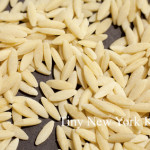From Concord to Emperor, there are so many delicious grape varieties available.
Whether tossed in a salad, baked into a dessert, or straight off the vine, these bite-size globes are packed with flavor.
Bursting with fiber, vitamin C, and loads of antioxidants, this fruit packs a nutritional punch as big as flavor. Grapes make an ideal portable snack in less than 100 calories per cup.
Look for firm grapes that are brightly colored and securely attached to their stems. Avoid bundles with wrinkled, dull skin or packages that have a lot of fruit floating at the bottom of the bag. When all else fails, try one.
Although there are thousands of varieties of grapes, the most popular are Thompson and Emperor seedless. Thompson grapes are sweet and crisp with vibrant green skin, amazing for snacking. Emperor red grapes have a sweet and tart flavor and are super juicy, making them great for baking.
Emperor or Flame: With their sweet flavor and long shelf life, these large seedless grapes are one of the most popular varieties.
Thompson Green: In America, 90% of these classic green grapes are produced in California. They are used for snacking, making wine, and raisins.
Concord: Created in Concord, Massachusetts, these grapes are known for their thick, blush skin and sweet candy-like flavor.
Freeze Them: Pick grapes off the vine and place them in a resealable plastic bag. Freeze overnight for a healthy, frosty treat.
Bake Them: To make raisins at home, cook grapes for 30 seconds in boiling water and place in a bowl of ice water. Preheat the oven to 170 degrees and place grapes on a parchment paper lined baking sheet. Bake until they have dried out completely. Toss grapes halfway through to prevent sticking.
Blend Them: Blend grapes with a bit of water and pour through a fine mesh strainer for a fresh glass of grape juice.
“Work With What You Got!”
© Victoria Hart Glavin Tiny New York Kitchen © 2017 All Rights Reserved
Orzo is the Italian word for barley; however, orzo is not made from barley at all, but rather from semolina, which is a course ground flour made from durum wheat. With its shape reminiscent of slivered almonds, orzo cooks up in about half the time of rice, making it a speedy standby to have on hand to add heartiness to meals.
Just bring 3 quarts of lightly salted water to a boil. Add 8 ounces ( 1 1/2 cups) dried orzo and boil about 10 minutes until it has a firm, chewy texture. Stir occasionally to prevent it from sticking together. Drain orzo in colander and serve immediately.
Rinse orzo only if it will be baked or served cold in a salad. Otherwise, do not rinse as rinsing removes a light coating of starch that helps sauces and seasonings cling to the pasta.
For the best texture and flavor serve orzo immediately after cooking. If your orzo gets done before the rest of the meal, you can keep it warm by returning the cooked drained pasta to the warm cooking pan. Stir in a little butter or olive oil to prevent it from sticking together. Cover the pasta with a lid and let it stand no more than 14 minutes.
“Work With What You Got!”
© Victoria Hart Glavin Tiny New York Kitchen © 2017 All Rights Reserved
One of the best ways to preserve the abundance of fresh herbs from your garden is by making flavored oils. Herb oils can be enjoyed so many ways – drizzled over salads, vegetables, pastas, sandwiches, or grilled items, hot or cold or at room temperature. Not only are they flavorful, but they also add dramatic color when drizzled on plates. If you want to add more flavor add half a clove of smashed garlic and 1/2 teaspoon crushed red pepper to the blender with the other ingredients, which makes a great dipping oil for chunks of rustic bread.
“Work With What You Got!”
© Victoria Hart Glavin Tiny New York Kitchen © 2017 All Rights Reserved
I’ve been making the most of cherry season these days and sometimes have to get a bit inventive to use them to the fullest. Here are some ways to make the most of beautiful summer cherries.
Breakfast: Make quinoa and top with almond milk and cherries for a nourishing hot cereal bowl.
Lunch: Pick your favorite whole grain to make a salad with cherries, arugula, almonds, and tarragon.
Snacks: Blend almond milk, creamy almond butter, and cherries to make a delicious smoothie.
Dinner: Grill salmon and serve with couscous combined with cherries, green onions, and toasted almonds.
Dessert: Make a cherry crisp. You may want to throw in some dates or figs to give it a little extra heartiness.
Preserve: Make cherry jam, cherry syrup, or pickled cherries.
“Work With What You Got!”
© Victoria Hart Glavin Tiny New York Kitchen © 2017 All Rights Reserved
Just a few fresh berries add color and nutrients to a salad, cocktail, or mocktail.
Stock up on fresh berries, wash and freeze them in a single layer on a sheet pan. Then transfer to a freezer bag for future smoothies and baked goods.
Add a handful of berries to a parfait, with yogurt for breakfast or ice cream for dessert.
Gently fold berries into muffin and pancake batter. Cook a big batch and freeze some for easy breakfasts later.
Make into a savory salsa and serve as a dip or over grilled chicken or wild-caught salmon.
“Work With What You Got!”
© Victoria Hart Glavin Tiny New York Kitchen © 2017 All Rights Reserved
The orange carrot we know and love today came originally from Holland, but up until the Middle Ages, all carrots were purple. Gardeners often delight in such oddities, but you will be very lucky to find any purple specimens available in stores or supermarkets.
Carrots contain large amounts of carotene and vitamin A, along with useful amounts of vitamins B3, C and E. When eaten raw, they also provide potassium, calcium, iron and zinc, but these are partly destroyed with cooking.
Almost all vegetables have a better flavor if they are grown organically, but this is particularly true of carrots. If possible, buy organic ones, or look for the young, pencil-thin carrots that still have their feathery tops attached. These young carrots can be eaten raw, or steamed for a few minutes. Older carrots should be unblemished and feel firm. Carrots should not be stored for too long, but they will keep for several days in a cool airy place or in the salad drawer of the refrigerator.
The age of carrots is a guide to how they should be prepared. The valuable nutrients lies either in or just beneath the skin, so if the carrots are young, simply scrub them. Medium-size carrots may need to be scraped with a knife before cooking them and large carrots will need to be scraped or peeled. Carrots can be cooked or eaten raw. To eat raw, they can be cut into julienne strips and tossed with a dressing, or grated into salads and coleslaw. They can bee cooked in almost any way you choose. As an accompaniment, cut them into julienne strips and braise in butter and cider. Roasted carrots are delicious, with a melt-in-the-mouth sweetness. Par-boil large ones first, but younger carrots can be quickly blanched or added direct to the pan with a joint of meat.
“Work With What You Got!”
© Victoria Hart Glavin Tiny New York Kitchen © 2017 All Rights Reserved
Figs are truly fantastic! Dried figs are available all year round and many markets offer luxuriously sweet fresh figs throughout the year as well. Figs are a healthy and portable snack that is packed with nutrition.
Figs are rich in potassium, which helps control blood pressure. They also provide calcium, magnesium, iron, and copper. Because they’re rich in fiber, figs support digestive health and may be helpful for managing a healthy weight. Figs are among the most alkaline foods and help balance the body’s pH.
Fresh figs are highly perishable, so they should be eaten a day or two after you purchase them. Look for figs that have a rich, deep color and are plump and tender, but not mushy. Wash them under cool water and remove the stem. Add fresh or dried figs to oatmeal, salads, cheese, and baked goods.
“Work With What You Got!”
© Victoria Hart Glavin Tiny New York Kitchen © 2017 All Rights Reserved
5 Ways To Use A Vegetable Peeler
The humble vegetable peeler has hidden talents.
Easily Peel Fruit: To peel soft fruits and vegetables, like tomatoes and peaches, you usually have to briefly dunk them into boiling water. Using a good vegetable peeler is so much easier and faster. Look for peelers with serrated blades for the best results and select not-too-ripe fruit.
Shaved Cheese: Give salads, pastas and roasted vegetables a restaurant-style finish by garnishing with generous amounts of shaved Parmesan or pecorino romano cheese.
Vegetable Pasta: Shave long strips of zucchini, carrots (even sweet potatoes and squash) to transform them into pasta substitutes. Serve raw or briefly steamed with your favorite sauce, or toss with a vinaigrette for a fresh and nutritious salad.
Spreadable Butter: Is there anything worse than trying to butter toast or bread with rock hard butter straight from the fridge? Use a vegetable peeler to scrape off thin and perfectly spreadable butter ribbons.
Chocolate Curls: Peel the edge of a slightly softened chunk of chocolate to create curls, or the flat surface of very cold chocolate to make shavings. Keep your creations in the freezer and use to garnish cakes, pies, puddings and seasonal fruit.
www.tinynewyorkkitchen.com
“Work With What You Got!”
© Victoria Hart Glavin Tiny New York Kitchen © 2016 All Rights Reserved
Cooking With Lemons
Lemons are a chef’s secret ingredient. Most chefs will tell you that acidity elevates any dish. There is no need to get all fancy by using twenty year old balsamic vinegar. Just finish most of your dishes with a humble squeeze of lemon juice. Most line cooks have quart containers of wedges at their stations for juicing in the moment. Why lemon? Aside from the fact that you can always find one, you’ll taste what it does to the food, not the lemon itself. Along with salt and pepper, it’s all you need to season everything from simple pastas to grilled fish, roasted meats, and sautéed vegetables, as well as pan sauces, grain salads, and even run of the mill lentil soup. In your own kitchen cut lemon wedges ahead of time, then squeeze as you cook for the brightest flavor.
“Work With What You Got!”
© Victoria Hart Glavin Tiny New York Kitchen © 2016 All Rights Reserved















